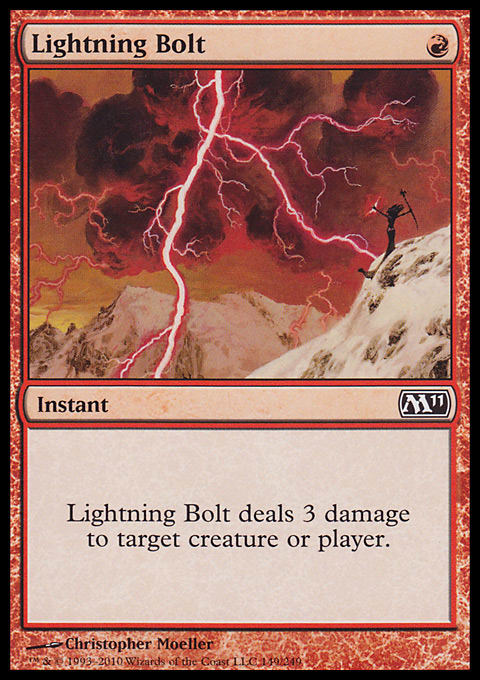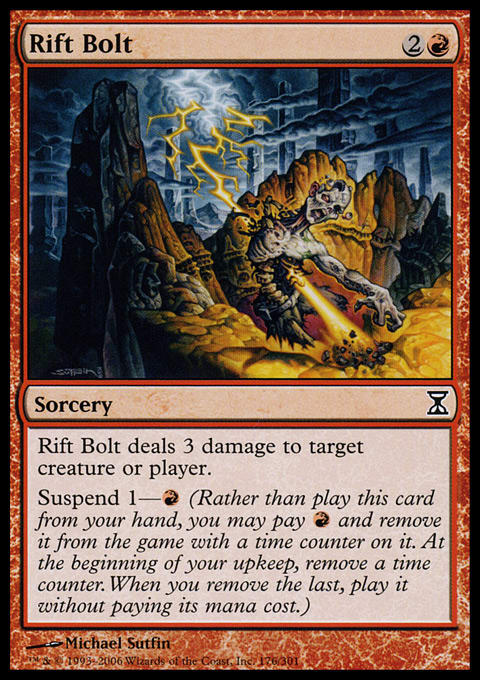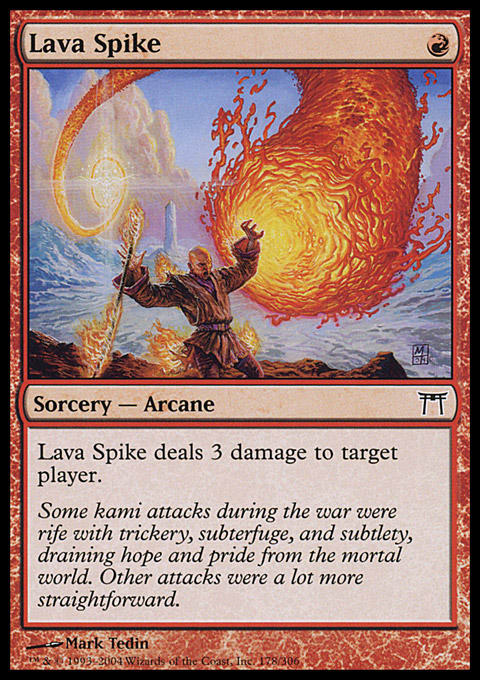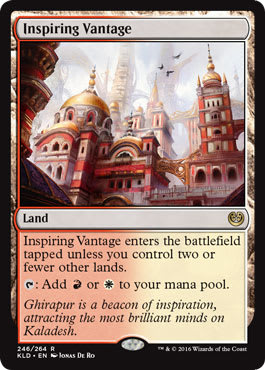Abstract:
- Mana Cost Superpower
- Minimizing Error
- Putting It All Together
Mana Cost Superpower
Think for a moment what makes a card like Lightning Bolt so strong; or Path to Exile . . . Or even Dismember.
At one time or another each of these cards was some version of the strongest card in Standard; some version of the most populous, at least (there were any number of Top 8s featuring 32 copies of Dismember, for instance). Each of them remains strong in Modern.
What makes them so good?
If your answer is “they only cost one mana” . . . That is part of it, sure, but not all of it. Lots of cards cost one, and lots of cards are good. These though?
From my perspective, these one (or faux-one) mana cost instants all punch above weight, cost-wise. A Lightning Bolt will sometimes trade with a Tarmogoyf or Vendilion Clique. A Path to Exile or Dismember — for just 1 mana — can halt the rushing, crushing, haste of a Reality Smasher.
But yeah, sure: They All Cost One
Being a little bit cheaper is one of the most powerful — if not the most powerful — features of a Magic card. Think back to this card:
It’s the best!
It is flexible — able to target creatures or players — and an instant to boot!
Almost any deck that can cast it does.
How about this card?
It’s just as flexible as Lightning Bolt: Again, able to target either creatures or players; and an instant, still. On top of the original features of Lightning Bolt, Incinerate can give you a little extra oomph against Modern Role Players like Experiment One. Yet . . . Incinerate is basically unplayable in Modern. The key difference between the two cards is 1 mana.
On balance . . .
Consider this card. It is in almost* every way inferior to Lightning Bolt. It costs three times as much on face value; it is a sorcery instead of an instant. Yet Rift Bolt is a highly played card in Modern while the instant speed, more flexible, more purely powerful (or at least slightly more feature-rich) Incinerate is unplayable.
Why?
Suspend ![]() .
.
This card is the even more extreme example, and “The One Simple Card That Will Help You Play Better Magic Modern”
Lava Spike is just the extraordinarily short short-bus version of Lightning Bolt. It costs the same amount of mana and it does the same amount of damage. Great and great! But Lava Spike is a sorcery where Lightning Bolt is an instant, and perhaps more importantly, while Lightning Bolt can target creatures or players, Lava Spike can only target players.
This, though, is its especial secret.
Minimizing Error
We live in an era, with so many websites and so many streamers and so many large tournaments each week, that deck lists are plentiful. So for now let’s just assume that all (or at least “all”) the available decks are good at some level. All on the same page, then? Great. We focus, I think, over-much on how decks work or which decks to select, rather than how to best play them once they have already been chosen.
Much of my notable Magic writing has been about how we formulate the decisions that guide our plays over the course of a game:
- Who’s the Beatdown? Mis-assigning your role, especially when playing against a similar strategy, will damage your likelihood of winning.
- Realizing How Bad You Are “A mistake is any play that is not the optimal play.”
- Magic: The Intangibles Every decision either reinforces or decreases your likelihood of winning
- Applied Conservation of Willpower Your capacity to make good decisions is limited
- Make the Play Monday “How does a wannabe start making those better plays that differentiate players with consistently superior performances?”
This time I will approach from a different angle.
Lava Spike is a Modern-playable card. That means that it is, already and by definition, good enough. Lava Spike is not as expensive as Tarmogoyf on the secondary market, nor as flashy as Ad Nauseam; it is, however, both consistent and well within the acceptable range of a Modern Magic: The Gathering card.
Lava Spike can only be cast one way. Unless the opponent has one or more Planeswalkers in play that means that You cannot err when playing Lava Spike. It is literally impossible to screw up (presuming you are supposed to play it).
Yes, there are trade-offs; you can probably only play it in circa one strategy.
BUT . . .
Because you can’t screw up with it, playing Lava Spike automatically helps you play better Magic!
Isn’t that great?
My friend and podcast partner Patrick Chapin talks about “The A.I.” He utilizes a system so that, to the extent possible, his deck plays itself and he strives to make the minimum number of decisions in-game. Everything from how he lays out his lands to how he orders his graveyard emanates from Patrick’s practice rather than his conscious mind during games. Keep in mind that in addition to having the coolest podcast partner, he is both a Pro Tour Champion and a member of the Hall of Fame.
We can choose deck lists (like The Lava Spike deck) to key on The A.I.
Got there! #pptq winner / #rptq Dublin here I come 😀 Thanks @BasicMountain pic.twitter.com/7DeX8wd31Y
— Michael Flores (@fivewithflores) August 7, 2016
A few months ago I took down a Modern PPTQ with this Lava Spike deck. My version had some legs, won a few more PPTQs, and helped Miles Rodriguez make Top 8 of the New Jersey Invitational.
One of the key features of this deck is that it plays no Wild Nacatl.
Putting It All Together
Isn’t Wild Nacatl good?
I suppose it can be good, but I don’t think it is a particularly good Modern card, especially right now. Wild Nacatl has a lot of contextual stuff going against it. It is pointlessly brickwalled by Thing in the Ice. Unlike Lava Spike, it forces you to make all kinds of decisions, often fruitlessly. Should I fetch for this land or this land? When fetching, should I take extra damage? Should I attack or leave the Cat back to block? Since Wild Nacatl doesn’t have haste — but at the same time is out-classed by a huge portion of Modern’s playable creatures once actually on the battlefield — those decisions, are again, often costly but bear no Return on Investment (ROI).
Non-contextually Wild Nacatl does two things very poorly:
- It makes the opponent’s removal good. Remember way at the top when we were talking about trading up on mana with Lightning Bolt or Dismember? Much of the removal in Modern actually trades down against a Lava Spike deck. Abrupt Decay, Maelstrom Pulse, and Terminate all stink against Goblin Guide, Monastery Swiftspear, and Eidolon of the Great Revel. They all tend to cost equal or more mana . . . Against cards that already got their money by virtue of haste or Eidolon’s trigger. They technically “work” but also all drag on efficiency, even jam up your own hand.
- It makes your best card bad.
In the time since I won my August PPTQ the Lava Spike deck in Modern got a substantial upgrade in Inspiring Vantage. Since a 20-land deck tends to have four lands in play relatively rarely, Inspiring Vantage is largely functionally Plateau (i.e. the best possible card) . . . Except for purposes of buffing Wild Nacatl. One card is marginal and a non-bo with the best card.
Easy pick.
This is the deck I played at the Dublin RPTQ; though I was unsuccessful on that day, I would still heartily recommend it in Modern:
Burn ? Modern | Mike Flores
- Creatures (12)
- 4 Eidolon of the Great Revel
- 4 Goblin Guide
- 4 Monastery Swiftspear
- Instants (20)
- 4 Boros Charm
- 4 Lightning Bolt
- 4 Lightning Helix
- 4 Searing Blaze
- 4 Skullcrack
- Sorceries (8)
- 4 Lava Spike
- 4 Rift Bolt
- Lands (20)
- 2 Mountain
- 2 Sacred Foundry
- 4 Bloodstained Mire
- 4 Inspiring Vantage
- 4 Scalding Tarn
- 4 Wooded Foothills
- Sideboard (15)
- 4 Relic of Progenitus
- 3 Deflecting Palm
- 3 Sudden Shock
- 1 Wear // Tear
- 2 Path to Exile
- 2 Kor Firewalker
This deck is great against 1) a majority of the actually good decks in Modern, and 2) decks people actually play. By (2) I mean it is an overwhelming favorite against decks like U/R Thing in the Ice and Jund. It is relatively poor against Dredge but awesome against Infect and an absolute lock in the mirror. There are few decks with as many good matchups and none that I can think of that are so lopsided against such good and / or popular decks.
Even before Inspiring Vantage, I gravitated towards Boros over Naya soon after winning my PPTQ for two reasons:
- I wasn’t really getting anything from Green, but I was consistently taking an extra couple of points just by having Stomping Grounds in my deck. Atarka's Command was rarely anything but Skullcrack for me (I think I did the creature buffing thing one total time in tournament play, lifetime); and it is actually inferior given Skullcrack’s additional text against playable defenses like Fog. As good as Destructive Revelry is, you’ve never seen a demoralized opponent until you’ve gotten a turn zero Leyline of Sanctity + turn one Chalice of the Void (off of Simian Spirit Guide) with your one Wear // Tear! The color trade-off is minimal once you’ve accepted that Wild Nacatl stinks. The 2-6 life point boost in a format where most games are decided by turn four though? Invaluable.
- This build reinforces all the things that help Lava Spike narrow your play. It is extremely difficult to leak points (points or percentage) with the mana configuration. You no longer have to stress over attacking or leaving up a Mountain with Grim Lavamancer . . . There aren’t any more! The two extra Lightning Helixes, on the other hand, have done things like helped race a turn three flipped Thing in the Ice. The combination of low-pain mana base and ability to gain enough life to withstand an additional seven-shot cements this build’s advantage over U/R.
Part of what makes Lava Spike (both card and deck) so good in Modern is that the lines of play are relatively straightforward. There is one fork that comes up relatively often that newer players don’t necessarily know how to handle.
When you are on the play, you don’t know what your opponent is, and you have the choice between Lava Spike and Rift Bolt, suspend Rift Bolt. There are multiple reasons for this, but the two most important are 1) you won’t necessarily have the ability to fast-play the Rift Bolt to overload the opponent later, and 2) if the opponent is Infect or Bant Eldrazi, suspending a Rift Bolt is essentially a Time Walk; they won’t play Glistener Elf or Noble Hierarch for fear of losing it tapped out; the Time Walk there can be invaluable in a race.
LOVE
MIKE
* I once beat a Chalice of the Void for one and a Chalice of the Void for two by drawing all my Rift Bolts. So . . . almost.

























